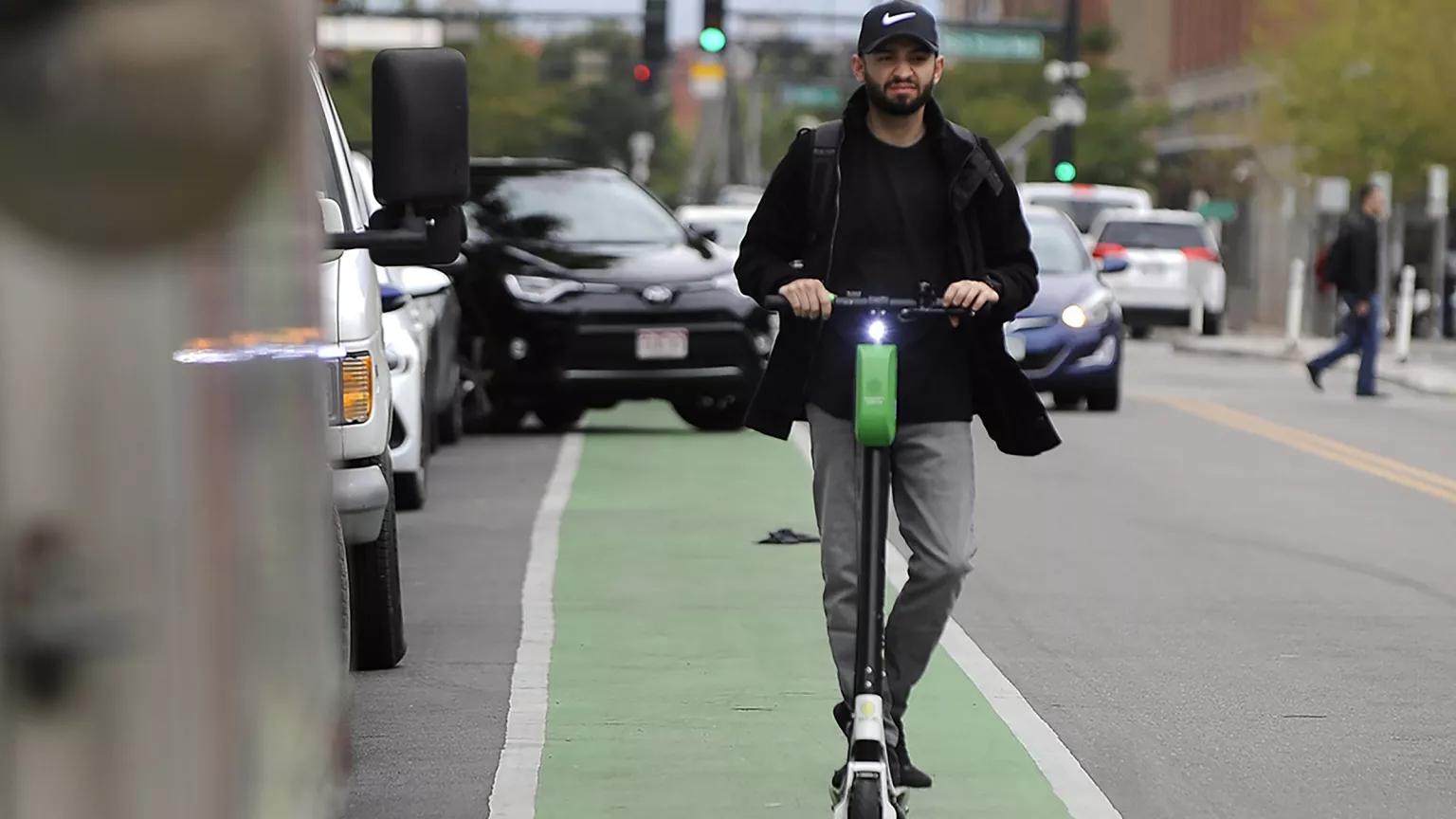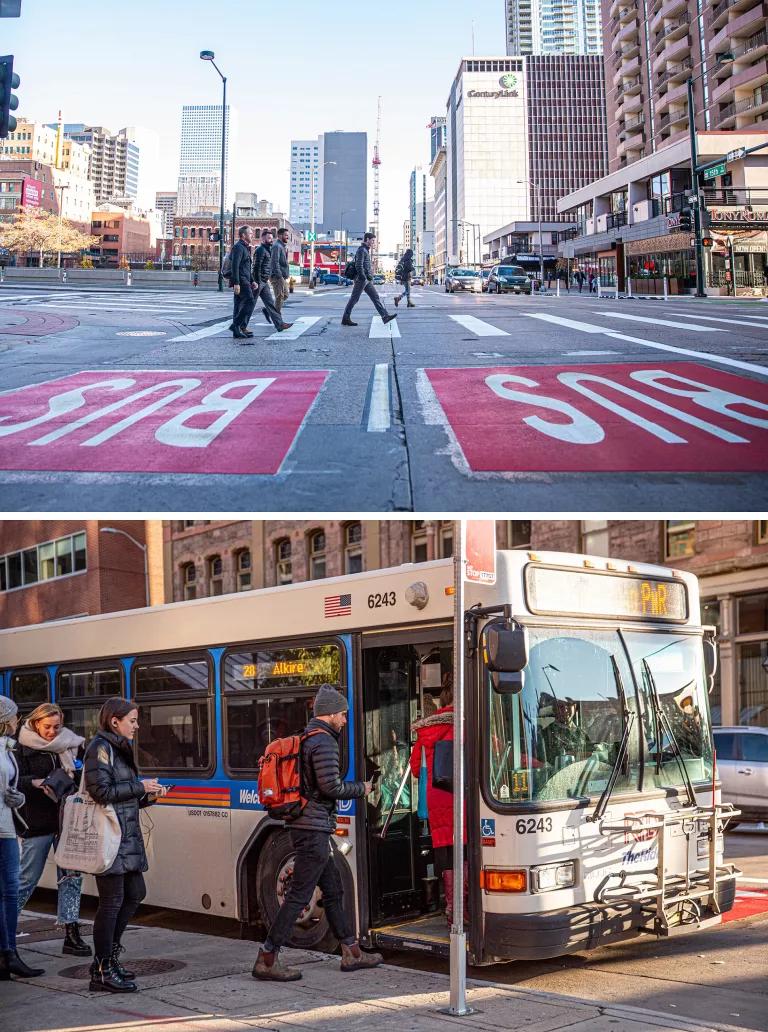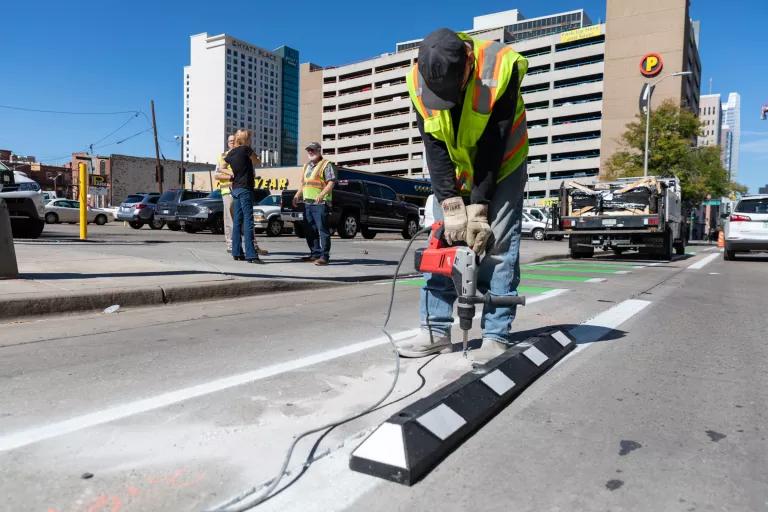Denver Wants to Zoom Past Its Car-Centric Street Design
City officials see dedicated bus corridors, scooter-share programs, and protected bike lanes as key to greening their transportation network.

E-scooter user riding in a designated bike lane in downtown Denver
Kathryn Scott
Denver commuter Gerald Moore drives from his home in the Washington Park neighborhood to his office downtown five times a week. The trip is only a few miles, and there are buses that travel the same route, but, he says, “it seems like they’re always delayed and running late. If I have a meeting in the morning, I can’t risk being late.”
Moore isn’t alone in his skepticism of the city’s public transit system’s reliability—nearly three out of every four Denver workers drive solo to work. But the city wants to change that in light of the fact that emissions from the transportation sector are the leading source of air pollution and the second-leading source of greenhouse gases in Denver. In 2017, Mayor Michael Hancock announced a goal to reduce the ratio of solo drivers from 73 percent to 50 percent of commuters by 2030. In 2019, it became one of 25 winners of the American Cities Climate Challenge, an honor that recognizes Denver’s dedication to reducing carbon emissions from its buildings and on its streets. The city’s leaders and voters further affirmed their commitment to greening public transit last year by approving the creation of the new Department of Transportation & Infrastructure (DOTI).
The goals set forth in Hancock’s Denver Moves plans center “around mobility and ways of getting people out of cars and into more sustainable transportation options,” says NRDC’s Denver climate advisor Alana Miller. “Historically, there has been a lot of investment in our roads’ infrastructure and most of that street space is dedicated to cars,” rather than buses, trains, or bikes. As a result, “people are so reliant on driving their cars, their trucks, and their SUVs to work, school, and the grocery store.”

Recently added dedicated bus lanes on 15th Street in downtown Denver
Lisa Ferrante for BPI/Bloomberg Philanthropies
At the end of last year, the city rolled out dedicated bus lanes on the right sides of its bustling 15th and 17th Streets, to whisk commuters more swiftly through the downtown area. The roadways serve as major corridors for bus commuters traveling into the city from surrounding neighborhoods, and the downtown stretches are often plugged with cars. “At rush hour, the streets carry as many as 60 buses each hour,” Miller says. “So it’s really important to be able to get them out of traffic and moving along as quickly as possible to make it a more efficient route.” The hope is that city buses will soon overtake cars as the most convenient way for commuters to get to work.
“We know that in a growing city...we need to move more efficiently,” said Joel Noble, a volunteer member of the Denver Moves: Transit Task Force, during a 2019 city press conference announcing the rollout of Comprehensive Plan 2040, which sets up a 20-year vision for city priorities.
The problem of the city’s history of prioritizing cars over public transportation options is compounded by the fact that public transit in Denver is managed by the Regional Transportation District (RTD), which must balance the needs of city commuters with those of travelers throughout the roughly 2,400-square-mile, 3 million–person metro region.
As a result, Noble said at the press event, “We know we can’t just turn to RTD and say, ‘Make [the transit network] work better.’ It’s up to the city to make our streets work better for transit.”
The city, rather than RTD, does have full control over the physical roadways within the city, which has made the 15th Street improvements possible.
Julia Sandoval has been using the buses to get around downtown for years and has noticed the rides becoming faster and more reliable since the dedicated lane was installed. “I’ve been cutting about 15 minutes off my commute pretty much every morning,” she says. “I just wish more streets had [dedicated bus lanes].”
Her wish may soon come true—other major arterial roadways such as 18th and 19th Streets are in line for the same treatment as soon as later this year.
“All of this is aimed at building a network that’s more reliable to best serve all of Denver,” Miller says.
Encouraging bus ridership isn’t the only way Denver transit officials are trying to reduce emissions. The city is also embracing newer transportation options, like electric scooters. Along with bikes, they can serve as effective tools to get people from their homes to bus stops or to train stations for those residents who live too far from transit hubs to walk, often referred to as first- and last-mile connections. This can be particularly critical during colder months.
On a chilly December afternoon, Jackson Lee zipped up to the entrance of a convenience store on 11th Street in Capitol Hill atop a Lime scooter, toed down the kickstand, and ran inside to grab a soda. “I use these things all the time,” he said gesturing to the sleek black-and-green scooter parked on the curb. “They’re everywhere, so I ride them to the gym, to the store, even to the Rockies games.” While Lee admits he’s heard complaints by others who see the scooters as nuisances—accusing riders of “blocking sidewalks and always in the way,” he says, he’s a big fan. “They’re an awesome addition to Denver.”
The city is reviewing the results of a one-year pilot program for dockless scooters and leaders are expected to soon bring forward plans for a permanent program. E-scooter riders in the city have traveled nearly 3.5 million miles since August 2018. After releasing a Request for Proposals (RFP), transportation officials will select new partners to manage the e-scooter program, as well as a bike-sharing program, since the long-running Denver B-Cycle ended on January 30.
Making scooters and bikes more readily available is just one piece of the puzzle. Denver transit officials are also striving to make it easier and safer to ride along city roadways. As part of the American Cities Climate Challenge, “Denver is doubling down on biking infrastructure and the bike lane network,” Miller says. “There is a lot of research that shows that people feel safer and are more likely to ride a bike if they are separated from cars. In Denver, there is often just a line of paint separating cyclists from cars, which can make people uncomfortable.” (City officials in San Jose, California, another metropolis participating in the Challenge, recently responded to those same concerns by rolling out new safe bike paths.)

Installation of a rubber curb along the 15th Street bikeway, September 2019
Andy Bosselman
DOTI crews have begun installing protected bike lanes with rubber curbs and plastic bollards, along with traffic-calming corner wedges. “Safer streets create safe lives; safer streets also help promote life,” said the department’s executive director Eulois Cleckley at a press conference in January outlining the enhancements. “[We’re] making sure people have the ability, regardless of the mode that they choose, to get around in a safe manner—to go to places of work or experience all the amenities that the city has to offer.”
Local cyclists like Matt Nesbit appreciate those changes. As he rested for a moment against his bike near the entrance to Cheesman Park, he noted that even as an experienced rider, on daily trips from the city’s Five Points neighborhood, “I still get nervous about being hit by a car on some of the roads around here. The more protection the city can give to us bikers, the safer it will be for us and drivers.”
Biking advocates have been drawing renewed attention to the city’s inadequate road safety measures, including through a Critical Mass ride last August in honor of two cyclists who were fatally struck by cars over the summer, less than two weeks apart. The cyclists see Denver’s current bike lane system as scattershot throughout the city, with lanes that don't necessarily connect to each other nor to popular travel routes. To address these problems, the city is shifting focus away from spreading lanes evenly throughout its street grid and focusing more on developing connected networks of lanes. Denver’s climate goals include the construction of 125 miles of bike lanes by 2023.
Residents and city officials alike are eagerly awaiting these changes to their transportation infrastructure, Miller notes. “People are really clamoring for more. They want to see more and to see it faster.”
This NRDC.org story is available for online republication by news media outlets or nonprofits under these conditions: The writer(s) must be credited with a byline; you must note prominently that the story was originally published by NRDC.org and link to the original; the story cannot be edited (beyond simple things such as grammar); you can’t resell the story in any form or grant republishing rights to other outlets; you can’t republish our material wholesale or automatically—you need to select stories individually; you can’t republish the photos or graphics on our site without specific permission; you should drop us a note to let us know when you’ve used one of our stories.

How You Can Stop Global Warming
A Consumer Guide to the Inflation Reduction Act
A Climate Strategy for India Scales Up